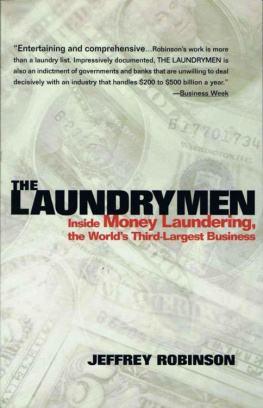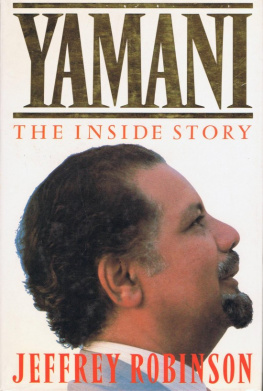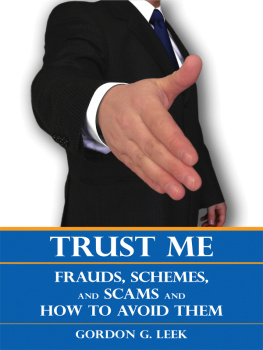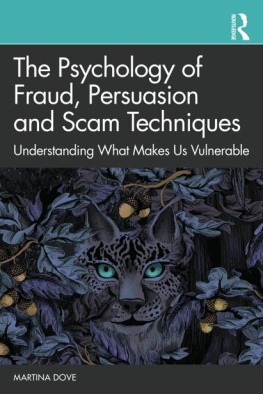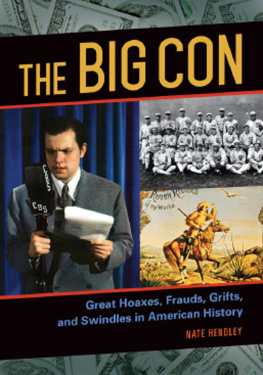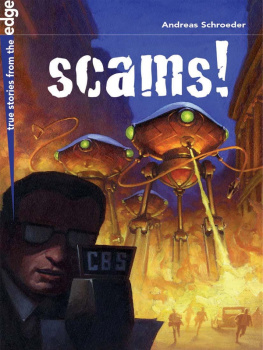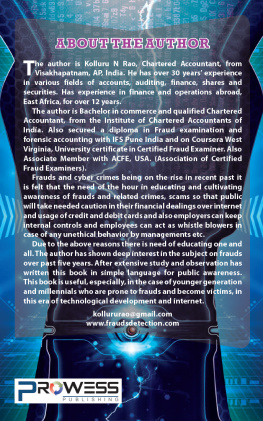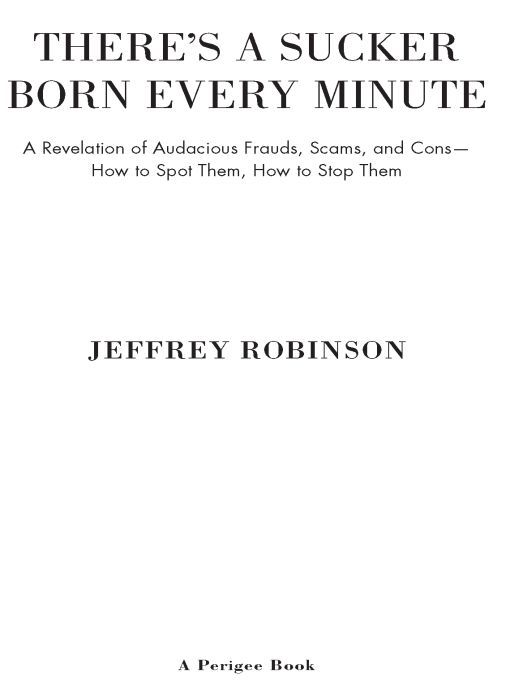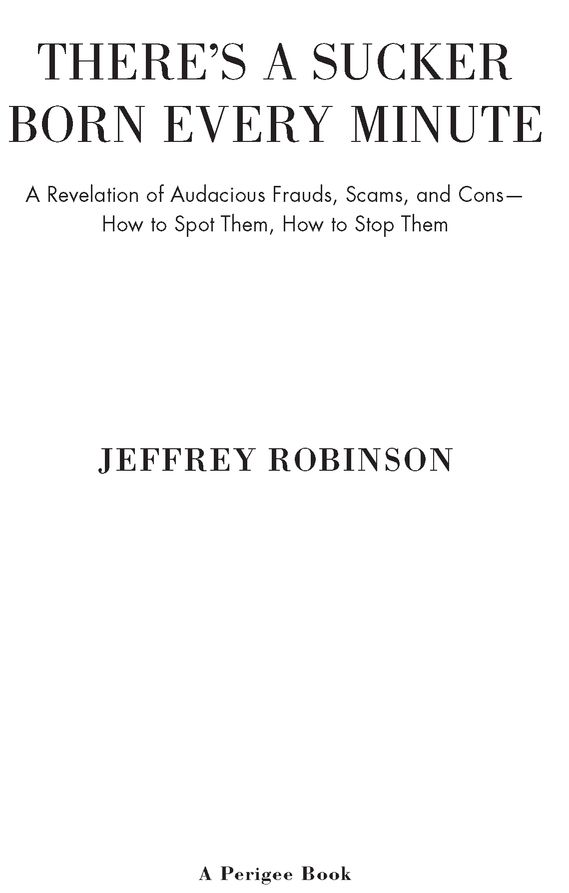Table of Contents
This book is dedicated to my friend Special Agent Bob Levinson, FBI (Retired) missing in action
THE PATRON SAINT OF FRAUDSTERS
THE patron saint of fraudsters has got to be P. T. Barnum, the circus impresario generally credited with the con mans motto Theres a sucker born every minute.
As the story goes, sometime around 1869, Barnum set out to buy the Cardiff Giant, a ten-foot hoax made out of gypsum and carved to look like a crude, ancient, fossilized man. It was supposedly discovered on a remote farm near Syracuse, New York, and, given the publicity that surrounded the discovery, was soon drawing paying crowds of three thousand gullible people a day.
Barnum, who knew a great scam when he saw one, offered a substantial sum to bring the Giant to New York City, where he felt he could sell ten times as many tickets. But one of the Giants investors, David Hannum, didnt like Barnums terms. So, Barnum did the next best thing and made a Cardiff Giant of his own.
Hannum is the one who supposedly said that anyone paying to see Barnums copy proved the adage Theres a sucker born every minute. A lawsuit followed, during which the two men admitted that both their Giants were fake. And somewhere in the confusion, the quote by Hannum got attributed to Barnum.
Except there doesnt appear to be any record of Hannum ever saying it. Or Barnum, either.
Another story credits the quote to a Barnum rival, Philadelphia circus promoter Adam Forepaugh. He purportedly came up with it during an interview in which he tried to discredit Barnum by telling a reporter that it was Barnum who always preached theres a sucker born every minute.
Yet another account tags it to Michael Cassius McDonald, a saloon keeper and politician in Chicago during the 1860s. But his title to authorship appeared in a book published in 1940. By then, the expression had already been in print several times. In John Dos Passoss 1930 epic, 42nd Parallel, its attributed to Mark Twain, and it also appears in A Yankee from the West, an 1898 novel by someone called Opie Read.
The eminent amateur etymologist Barry Popik has since tracked half a dozen appearances of variations on the expression to as far back as 1857. He notes that early appearance in the New York HeraldThere is a new fool born every dayand another in 1906, when the New York Evening Mail perpetuated the original myth by writing about a certain politician who will get all the votes coming to a political Barnum whose motto is that of the original Barnum: A sucker is born every minute.
In fact, Popiks research suggests that the phrase was not coined, but rather part of an era, just one of those things often said by New York gamblers in the early 1880s.
A man frequently cited from those days was the notorious New York con man Joseph (Paper Collar Joe) Bessimer. According to a widely held version of the tale, Bessimer used the expression as an excuse to explain his criminal successes to the New York Police Departments Inspector Alexander (Clubber) Williams who, at the time, was in the process of arresting him. Williams is said to have repeated Paper Collar Joes phrase to Joseph McCaddon, whose brother-in-law James Anthony Bailey was Barnums business partner. McCaddon then took the liberty of re-quoting Bessimer in an unpublished autobiography.
The only problem is that Clubber Williams was a famously bent cop who couldnt be trusted to tell the truth, and there is no record whatsoever in the New York police or court archives of any con mannotorious or otherwisenamed Paper Collar Joe Bessimer.
In the end, it seems that the origin of the quote has simply been lost to time.
But, the truth behind it, most definitely, lives on.
JEFFREY ROBINSON,
NEW YORK
PART ONE
CHAPTER ONE
A Two-Way Street Crime
FRAUD is a very simple crime to understandI tell you a lie, you give me money, thats fraud.
And it is never any more complicated than that.
Whether youre talking about someone who claims an extra $100 from his insurance company after a fender bender, a Nigerian government minister who is willing to share a just-discovered $40 million bounty with a perfect stranger, or scandals as big as Enron and Bernie Madoff, no matter how elaborate the scheme wrapped around the lie, no matter how complex the plot that a fraudster constructs to draw you into the lie, all frauds always boil down to just thata lie.
Once upon a time, in a simpler, more gentle world, those lies revolved around wild-eyed, yet somehow believable schemes that made you healthier or wealthier. There were elixirs that could cure snakebite and also grow hair, guaranteed-you-cannot-lose investments on patents for perpetual motion machines, phony royal titles for sale, and miles of beachfront Florida property that just happened to be under a swamp.
In that simpler world, the caveat was born: If its too good to be true, it aint.
These days, more than ever, the warning still applies.
In our complex, globalized, high-tech world, fraudsters are more skilled in their craft than ever before, more elusive through their use of technology, more erudite in their understanding of human desires, and more sophisticated when it comes to pushing all the right buttons. In our complex, globalized, high-tech world, fraudsters have become the most creative and the most capable liars in the history of the universe.
THINK of fraud as marketing, exactly like the advertising business. There is a product to sell, various tricks of the trade are used to entice you to buy, and once you buy, the Mad Men move on to the next customer.
This is not to suggest that advertising is a fraud. But Madison Avenue and con men use the same techniques to arrive at the same endto convince us to part with our money.
Consider this: Advertising is everywhere because it is, essentially, ego-gratifying. We like being told were unique, even if we are being asked to express that uniqueness by becoming part of a group. We are all looking for ways of fulfilling our dreams. We are open to solutions that will eliminate our problems and change our lives.
Now reread that paragraph and for the word advertising substitute the word fraud.
Consciously or not, we accept advertising because it offers us new ideas and, until now, the old ideas havent always worked. Consciously or not, we recognize the fraudsters premise that a problem existsa lack of money, a lack of status, not enough sexand hes offering us a solution.
Academics suggest that the true power of Madison Avenue lies in the fact that so many people are fast to claim they cannot be influenced. They insist that they dont pay attention to ads, never watch them, tune them out, and that ads have no effect on them. These are the same people who walk around wearing Budweiser baseball caps and Fruit of the Loom T-shirts.
You hear similar things from people about fraud. I cant be seduced into giving some stranger my money. Im too smart. Im not that stupid. These are the same people who buy into pyramid schemeshey, if someone is going to send me $750, why not?and order miracle overnight weight loss pills on the Internet.
Studies have shown that seven out of ten consumers believe companies use ads to exaggerate the benefits of their products. So if advertising lies to us and we know it, why do we still buy the products? Same question: If fraud is a lie, why do we fall for fraud?



